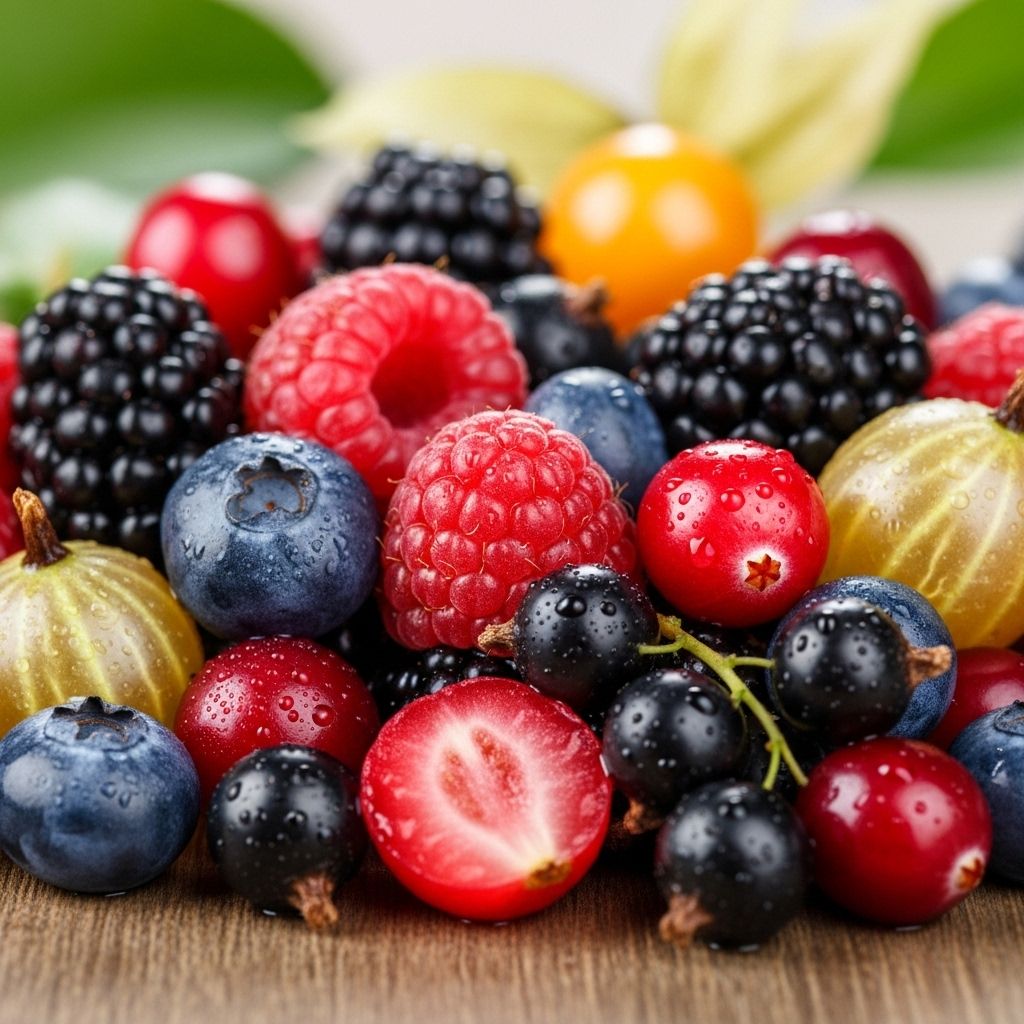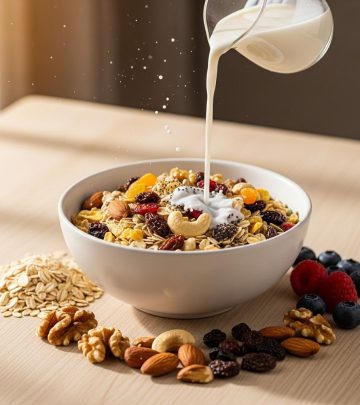Superfoods: Antioxidant-Rich Berries – Beyond Blueberries
Discover the antioxidant-packed potential of berries beyond blueberries, exploring their unique benefits, nutrients, and simple ways to add them to your daily routine.

For years, blueberries have enjoyed the spotlight as the quintessential superfood, celebrated for their remarkable antioxidant content. Yet the world of berries is far more variegated and generous: from the tart and vibrant cranberry to the intense hues of blackberries, and the exotic appeal of goji berries, these fruits bring not just a burst of color and flavor, but a concentrated pack of vital nutrients and health-promoting compounds that deserve equal acclaim. This article explores the broad landscape of antioxidant-rich berries, their unique health benefits, and accessible ways to incorporate their power into everyday eating.
What Makes a Berry a Superfood?
The term “superfood” is often used to describe foods extremely rich in nutrients and health-promoting compounds. Berries typically qualify due to their exceptionally high levels of antioxidants—molecules that help neutralize damaging free radicals in the body. Key antioxidants in berries include anthocyanins, flavonoids, resveratrol, and vitamin C. These directly contribute to a multitude of potential health benefits, including lowering the risk of chronic disease, supporting gut health, promoting cognitive function, and even lifting mood.
The Power of Antioxidants in Berries
Berries with intense red, blue, or purple hues signal the presence of powerful natural pigments known as anthocyanins. These antioxidants are responsible for combating oxidative stress, reducing inflammation, and protecting cells from damage. Berries—whether common or exotic—are versatile sources of a wide variety of potent (and, in some cases, unique) health-promoting compounds:
- Flavonoids: Compounds like quercetin and catechins that have anti-inflammatory and immune-supportive properties.
- Phenolics: Offer strong free radical scavenging activity.
- Resveratrol: Famous for its possible role in supporting cardiovascular health, most notable in darker berries.
- Vitamin C: Defends cells, boosts immunity, and aids collagen production.
- Fiber: Promotes gut health and helps regulate blood sugar.
Going Beyond Blueberries: A Closer Look at Other Superberries
Although blueberries are a nutritional powerhouse, several other berries offer complementary profiles of phytonutrients and antioxidants. Here are some compelling alternatives:
1. Blackberries
Blackberries are prized for their deep color and sweet-tart flavor. Rich in vitamin C, vitamin K, manganese, and an impressive blend of anthocyanins, these berries are noteworthy for their potential to:
- Protect cardiovascular health by supporting healthy blood pressure and lowering bad cholesterol
- Boost immune function through plentiful vitamin C
- Support healthy bones with vitamin K
- Reduce risk of certain cancers due to their potent antioxidant content
How to enjoy: Add fresh blackberries to oatmeal, toss into salads, or cook into a compote for yogurt parfaits and desserts.
2. Raspberries
Raspberries are a fiber-rich option, offering around 8 grams per cup, and providing high levels of ellagic acid, another antioxidant compound shown to have cancer-protective properties. Their tartness and subtle sweetness make them a refreshing addition to many dishes. Specific benefits include:
- Supporting weight management due to high fiber and low calories
- Combating inflammation
- Protecting cells from damage with abundant polyphenols
How to enjoy: Sprinkle over breakfast cereals, blend into smoothies, or pair with dark chocolate for a decadent, antioxidant-packed treat.
3. Strawberries
Bright red, juicy strawberries may be among the most familiar and loved berries. They are rich in vitamin C, manganese, folate, and various polyphenols. Research suggests the following:
- Help lower blood pressure and reduce heart disease risk
- Support skin health and collagen formation due to high vitamin C
- Deliver anti-inflammatory effects
How to enjoy: Serve fresh as a snack, slice over pancakes, muddle into water for natural flavoring, or use in salsas alongside avocado and tomato.
4. Cranberries
Best known for their role in urinary tract health, cranberries also contain high levels of proanthocyanidins that may keep bacteria from adhering to surfaces in the bladder and gut. They’re rich in vitamin C and fiber, but are often consumed dried or sweetened due to their tartness. Highlights include:
- Reducing risk of recurrent urinary tract infections (UTIs)
- Promoting oral health and reducing certain forms of inflammation
- Providing digestive support through non-digestible fibers
How to enjoy: Blend into smoothies, stir chopped cranberries into muffins, or simmer into zesty chutneys for savory dishes.
5. Goji Berries
Goji berries (sometimes called wolfberries) are small, bright red berries long prized in traditional Chinese medicine. They stand out as a unique superfood due to their broad spectrum of nutrients and bioactive compounds, including:
- High antioxidant activity, featuring polysaccharides, carotenoids (notably zeaxanthin), and flavonoids
- Support for eye health thanks to zeaxanthin, which protects against age-related macular degeneration
- Potential immune-modulating properties and support for healthy skin
- Benefits influenced by berry variety, geographic origin, and harvesting factors
Goji berries contain both water-soluble flavonoids (in black varieties) and high levels of carotenoids (in red varieties). Black goji berries in particular show especially potent antioxidant capacity—and all goji berries offer antimicrobial, anti-inflammatory, and even possible anti-obesity effects.
How to enjoy: Soak dried berries to soften them, add to hot tea, or stir into trail mixes, granola, porridge, or salads for a pleasant chewy texture.
6. Acai Berries
Native to South America, acai berries are deep purple, often consumed in frozen pulp or powder form. They are best known for their remarkable levels of:
- Anthocyanins, the pigments responsible for their deep color and associated antioxidant potency
- Healthy plant sterols that may support cardiovascular health and reduce cholesterol
- Potential neuroprotective properties that support healthy aging
How to enjoy: Use acai puree in smoothie bowls, top with sliced fruits and nuts, or blend into refreshing drinks.
Comparative Antioxidant Content of Berries
| Berry | Main Antioxidants | Additional Key Nutrients | Notable Benefit |
|---|---|---|---|
| Blueberry | Anthocyanins, flavonoids, vitamin C | Manganese, fiber | Brain & heart health |
| Blackberry | Anthocyanins, vitamin C, vitamin K | Fiber, manganese | Cardiovascular protection |
| Raspberry | Ellagic acid, vitamin C | Fiber, manganese | Weight management, cancer prevention |
| Cranberry | Proanthocyanidins, vitamin C | Fiber, vitamin E | Urinary tract health |
| Goji Berry | Polysaccharides, zeaxanthin, vitamin C | Protein, vitamin A | Eye & immune health |
| Acai Berry | Anthocyanins, plant sterols | Healthy fats, vitamin A | Anti-inflammatory & brain health |
Key Health Benefits of Antioxidant-Rich Berries
- Cognitive Support: Antioxidants in berries help preserve cognitive function and may reduce the risk of neurodegenerative diseases, including Alzheimer’s and Parkinson’s.
- Cardiovascular Health: Consumption of berries is linked to reduced blood pressure, improved cholesterol profiles, and decreased inflammation, all of which support heart health.
- Cancer Risk Reduction: Some compounds (e.g., ellagic acid and anthocyanins) found in berries can help neutralize carcinogens and prevent growth of certain cancer cells.
- Blood Sugar Regulation: High fiber content slows release of sugars into the bloodstream, helping stabilize blood sugar after meals.
- Immune Enhancement: The abundance of vitamin C and polyphenols supports immune defense and reduces infection risk.
- Mood and Skin Health: Regular consumption supports mood balance and youthful skin by reducing inflammation and promoting collagen formation.
How to Add More Antioxidant-Rich Berries to Your Diet
Getting more superfood berries into your daily diet is easier than you might think. Here are some practical tips:
- Breakfast boost: Stir fresh, frozen, or dried berries into yogurt, oatmeal, or overnight oats.
- Snack solution: Enjoy a handful of berries alone, or with a complement like nuts or dark chocolate.
- Baking upgrade: Add berries to muffins, pancakes, breads, or scones for extra nutrition and flavor.
- Savory options: Toss berries into salads with wilted greens, grains, cheese, or nuts, or make a berry vinaigrette for dressings.
- Drinks and desserts: Blend into smoothies or use as a vibrant topping for frozen treats and parfaits.
Frozen berries retain nearly all their nutritional value, making them an affordable, year-round option. Wild or locally foraged berries can provide unique flavors and an extra antioxidant boost, as long as you can identify them safely.
FAQs About Antioxidant-Rich Berries
Q: Are frozen berries as nutritious as fresh berries?
A: Yes—freezing preserves most of a berry’s nutrients, particularly antioxidants, making frozen berries a convenient and healthy choice.
Q: Do all berries have high antioxidant levels?
A: Most edible berries offer significant antioxidants, but the content and types of antioxidants can vary by species, growing conditions, and how they’re processed. Generally, darker berries (such as blackberries or black goji) have higher anthocyanin content.
Q: How many servings of berries should I eat each week?
A: Health organizations typically recommend a minimum of 2–3 servings (about 1/2 cup per serving) of various berries per week for maximum health benefit, though more can be enjoyed as part of a balanced diet.
Q: Can berries help with weight management?
A: Berries are naturally low in calories and high in fiber and water, which helps you feel full and satisfied. Some types, such as blueberries and strawberries, have been specifically associated with easier weight maintenance.
Q: Are there any potential risks or allergies related to eating berries?
A: Allergic reactions are rare but possible, especially with strawberries and less common berries. Dried and processed berries may contain added sugar or preservatives, so always check labels when purchasing packaged forms.
Key Takeaways and Getting Started
- Berries are among nature’s most powerful superfoods, offering a remarkable concentration of antioxidants and health-promoting nutrients.
- Diversifying the types of berries you eat—beyond blueberries—can offer a broader range of unique phytonutrients and benefits.
- Fresh, frozen, and even dried (unsweetened) berries are all excellent choices for daily nutrition.
By adding a colorful assortment of berries to your meals and snacks, you can enhance your health, satisfy your taste buds, and provide your body with a powerful arsenal of disease-fighting compounds. Let your next snack or breakfast bowl be a celebration of variety—because with berries, diversity truly means health!












